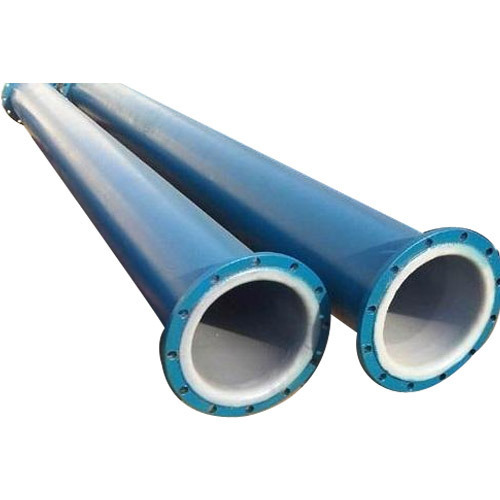Aimed at a prosperous growth in this domain, we are engaged in offering an excellent quality range of PTFE Lined Pipe.
Features:
Chemical Resistance: PTFE is chemically inert to all chemical and solvents with exception of molten alkali metals and strong fluorine donors. We use fine virgin PTFE powder(not any recycled material) to produce PTFE liners with the ultimate chemical and physical properties. PTFE lined pipe work can be used with aggressive media such as HCI, H2SO4(Various Conc.), HNO3, Hot NaOH Solutions, all chlorides-Organic and Inorganic, all phenols, all sulphates etc.
Temperature Resistance: PTFE has good flexibility and ductility in the temperature range of -50 to 235 deg. c. It should be noted that PTFE can be used at the higher temperature(above 200 deg c) and at the lower temperature (below -10 deg c) under certain conditions.
Resistant to Light and Atmospheric Condition: PTFE may be used without any problem in the open air and there are no mechanical and electrical characteristics even then subject to extreme climatic condition.
Operating Pressure:
PTFE lined pipework can be used up to 20 bar/300 psi.g.
Full vacuum resistance depending upon the process condition.
Electrical Properties: PTFE has good electrical insulation with a very low dielectric constant.
Material Specifications:
Pipe: ASTM-A 106 Gr.B, Seamless Sch. 40. All pipes spools have lap joint flange at one end and fix flange at other end. Lined pipes are available up to 3 meters. length max. (higher length available upon request.)
Flange: Flanges made from boiler quality plate material confirming to IS 2062 ASA 150 class and dimension as per ANSI B 16.5 depending upon material availability.
Collar: Collar made from boiler quality plate/ plate material confirming to IS 2062 depending upon the material availability.
Fittings: Formed and fabricated from seamless C.S. pipe/ductile casting lined with PTFE/FEP/PFA.
Lining: As per ASTM F 1545 / 95.
Minimum Flare Thickness: >80% of the actual extruded liner thickness
Flare Diameter: As per ASTM F 1545 / 95
Hydro Test: All 150 class pipes and fittings shall be tested at 25 bar after lining and 46.5 bar for 300 class pipes and fittings.
Electrostatic Test: A test voltage of 15 KV to 25 KV depending upon liner thickness.
Storage:
Pipe spools and fittings should not be stored in the open area.
Keep away from all source of corrosive vapour/ flame/ heat during storage.
Keep flare cover till pipes/fittings are installed to avoid damage and deformation of the flare faces.
Flange covers should be put back immediately on any section removed for inspection or for maintenance from the system.
Installation:
Gasket is not required between piping components except, where they are connected to a flange face of other material.
Metal part of pipe/fittings should not be used for electrical earthing.
Avoid rough handling, do not drop from a height.
Do not bend, weld, solder, braze on lined pipes/fittings.
Use expansion joints for thermal expansion of the long length of lined piping.
